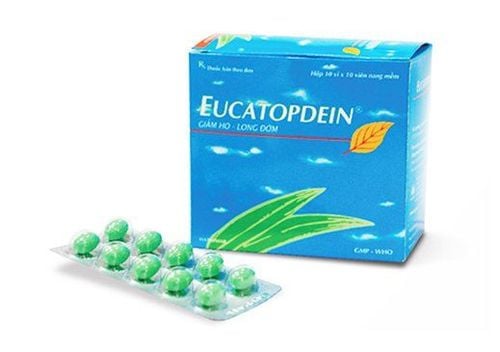This is an automatically translated article.
Methorphan is available in tablet or oral syrup form. The drug is indicated for use in the treatment of cough in many different diseases.
1. Uses of the drug Methorphan
Methorphan cough medicine is prepared in the form of a box of 1 bottle of 60ml, a box of 1 bottle of 100ml (Methorphan syrup) or a box of 2 blisters x 10 film-coated tablets. Each 60ml bottle contains: 60mg Dextromethorphan hydrobromide + 16.02mg Chlorpheniramine maleate + 120mg Guaifenesin + excipients. Each film-coated tablet contains: 10mg Dextromethorphan hydrobromide + 2.5mg Loratadin + 100mg Guaifenesin.
Cough medicine Methorphan has the pharmacokinetics of synthesizing the ingredients in the drug. They are:
Dextromethorphan: Cough treatment thanks to its ability to act on the cough center in the medulla oblongata, effective effects lasting 6-8 hours/dose taken once. This ingredient is quickly absorbed from the gastrointestinal tract, effective within 15 - 30 minutes after taking; Guaifenesin: Thins the sticky mucus of sputum and other bronchial secretions, makes it easier to expel sputum and secretions, shortens the duration of cough treatment, and soothes irritated airways; Chlorpheniramine maleate: Has an antihistamine effect due to its action on peripheral H receptors, against bronchospasm, relieves symptoms Indications for use of Methorphan:
Treatment of dry cough, cough due to flu, cough caused by allergy; Treatment of cough with phlegm in bronchitis, pneumonia. Contraindications to the use of Methorphan:
People who are sensitive to excipients and components of the drug; People who are having an acute asthma attack; People with symptoms of prostate enlargement; People with bladder neck ulcers; People with narrow angle glaucoma; People with peptic ulcer or pyloric obstruction; Persons being treated with MAO inhibitors; Women who are breastfeeding; Newborns under 6 months, premature babies.
2. How to use and dose of cough medicine Methorphan
2.1. How to use Each dosage form of Methorphan has a different use. Both pills and syrups are taken orally.
2.2. Dosage Dosage in tablet form:
Children 4 - 12 years old: Take 1 tablet/time x 3 times/day; People from 12 years old and above: Take 1-2 tablets/time x 3-4 times/day. Dosage in syrup form:
Children from 6-24 months old: Use 1.25 - 2.5ml/time (equivalent to 1⁄4 - 1⁄2 teaspoons); Children from 2 to 6 years old: Use 5ml/time (equivalent to 1 teaspoon); Children from 7 to 12 years old: Use 10ml/time (equivalent to 2 teaspoons); Adults: Use 15ml/time (equivalent to 3 teaspoons or 1 tablespoon); Frequency: Once every 6 hours, treat for 5-10 days. In case of overdose, the patient should notify the doctor and be hospitalized for treatment immediately. The doctor will prescribe appropriate symptomatic treatment and supportive treatment.
3. Side effects of Methorphan
When taking Methorphan, patients may experience some side effects such as:
Nausea and dry mouth; Dizziness, fatigue; Tachycardia , flushed skin; Calming effect, varying from lethargy to lethargy but may subside after a few days of discontinuation of the drug; Urticaria, exanthema: Rare.
4. Be careful when using Methorphan
Some notes users need to remember before and while using Methorphan cough medicine:
Methorphan medicine can cause drowsiness, loss of agility, alertness. Therefore, patients on medication should not drive or operate machinery; Chlorpheniramine component in the drug may increase the risk of urinary retention due to anticholinergic side effects, especially in patients with urinary tract obstruction, prostatic hypertrophy, pyloroduodenal obstruction, exacerbating this condition. in patients with myasthenia gravis; Patients taking Methorphan are at risk of respiratory complications, respiratory depression and respiratory arrest; Long-term use of Methorphan may increase the risk of tooth decay due to the anti-acetylcholine effect that causes dry mouth; Avoid medication for people with glaucoma such as Glaucoma; The use of dextromethorphan (the main ingredient of the drug) involves the release of histamine, so caution should be exercised in children with allergies; Prolonged, high doses of dextromethorphan can cause abuse and dependence on dextromethorphan.
5. Methorphan drug interactions
Some drug interactions of Methorphan include:
The sedative effect of chlorpheniramine is increased with alcohol consumption or when used concurrently with other sedatives; Monoamine oxidase inhibitors prolong and increase the anti-acetylcholine effect of antihistamines; Concomitant use of dextromethorphan with CNS depressants may potentiate the CNS depressant effects of dextromethorphan or these agents. During the course of using Methorphan, the patient should absolutely follow all the instructions of the doctor to ensure the best treatment effect, to avoid the risk of unpredictable side effects.
Please dial HOTLINE for more information or register for an appointment HERE. Download MyVinmec app to make appointments faster and to manage your bookings easily.













